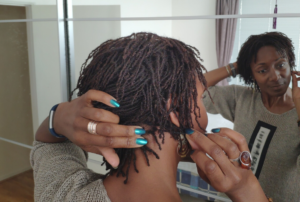After making some very bold statements in this earlier post about not doing a self-re-tightening, I’ve had a change of heart.
Before I go on, I want to mention that I am in no way detracting from the work of any Sisterlocks consultant. Doing the work calls for great attention to detail, a lot of manual dexterity, attending training and putting in long hours to build up a client list.
My point is that with all the re-growth, and no idea when I’d be able to go for my next re-tightening appointment, I felt that I had to take the plunge, so 2 weeks ago, I did a self reti. I used the Easyloc tool and I spent about a week doing my self-re-tightening. I have a 3-point rotation, and so, after finding out how to do it, I sat down and got on with the job in hand using a full-length mirror, a wheeled chest of drawers, a three-way mirror and some hair clips.
I didn’t keep a note of how long it took me in total but I typically sat for 2 to 3 hour stints, until I got it all done.
As I was doing my reti, I was struck by 5 things that I’d like to share with you:
- Re-tightenings don’t have to be painful. I’m very tender-headed and whenever I handle my hair, I do it very, very gently, especially when handling the hair around the delicate hairline area. While I was retightening my Sisterlocks, I realised that, as long as I didn’t do them too tightly (i.e. by putting in that extra rotation, because it looks like it can be done, and the realising – too late – while pulling through the loc, that I shouldn’t have done) I could take my time and do it gently, whether clipping the hair out of the way, parting the loose hair at the roots, pulling the loc through during each rotation, or clipping the re-tightened locs aside afterwards. The other thing that’s struck me about the lack of pain when self-retightening, was that because I didn’t do it all in one sitting and I think that helped my scalp to recover each time. As I mentioned, I spent a couple of hours each time working on a small section of my head. It meant the rest of my scalp (the sections not being retightened) were not being pulled in any way – and so the majority of my hair and scalp wasn’t experiencing the action of the lock being pulled through.
- I’m more invested in my Sisterlocks – which seems an odd thing to say, because often we talk about an investment of time or money – but by being invested in your Sisterlocks, I mean that the action of performing the re-tightening, as I worked through each one, made me pay more attention and feel personally attached to each one – checking them over, handling them with care, not taking them for granted, marvelling at them and having the feeling of being more committed to looking after them. Yes, it’s a low-maintenance hairstyle but the action of actually doing the work that goes into forming them for me meant being more appreciative of what is going on with them and taking on that responsibility – rather than palming that off on someone else. I hope I’m making myself clear on this point. The best example I can think of is in a work situation where you have your specific role to do, and while you’re doing that role, there are any number of different areas of work that are on the periphery. You don’t have to do those extra areas because, your job description says you don’t have to, but you realise that you could ‘stray’ into one or more of these areas, and when you do, you realise that by taking on those extra duties you’ve enriched your role.
- I’ve unveiled the mystery of re-tightenings – this point is somehow linked to the previous point. For me, the re-tightening process was shrouded in mystery. I booked my session, sat down and had a chat and a nap while it was being done and then went about my day-to-day life without giving the re-tightening process a second thought. But now, I understand what precisely is being done, the difference between a 3-point rotation and a 4-point rotation, which rotation I have, how to do it. No, I don’t know everything there is to know about it, because I’m not a fully trained consultant, but that lived experience means the mystery is there no longer.
- I’m taking notice of my scalp – I started to take more notice of my scalp. Generally, looking at my scalp isn’t something I do and before doing the self-re-tightening, I had spent little or no time looking at my scalp. While holding and clipping the Sisterlocks aside while self-re-tightening, I became more aware of my scalp and because of that I will make a point of checking it regularly for any signs of dryness or irritation.
- I’m feeling less fearful – I’ve had a few fears since starting the journey on this second set of Sisterlocks. What if I can’t get to my re-tightenings? What if I can’t afford to do my re-tightenings? What if my consultant isn’t available? And more recently…What if the lockdown goes on indefinitely? Now that I have done a re-tightening, those fears have been quietened, and it’s a great feeling.
So those are my thoughts. Overall, my self-retightening was ok – but I know I’ve made a few mistakes, like hooking in hair from adjoining Sisterlocks and when I go for my next re-tightening, some repair work will be needed.

(Original post date: 18th May 2020)

